Hyperthyroidism in Cats
HYPERTHYROIDISM IN CATS
[ad name=”Tweet”]
WHAT IS HYPERTHYROIDISM?
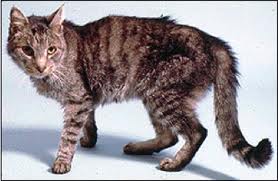 A Typical emaciated Hyperthyroid cat
A Typical emaciated Hyperthyroid cat
Hyperthyroidism is a condition in cats in which the thyroid glands produce too much thyroid hormone. The thyroid glands lie on the underside of throat, just below the larynx or Adam’s apple. Hyperthyroidism is the most common endocrine disease seen in first world countries in cats. It has just recently appeared in parts of the world such as Southern Africa and is in the increase there as well.
The thyroid glands normally produce and release thyroid hormone in response to the pituitary gland in the brain releasing another hormone known as thyroid stimulating hormone (TSH). The pituitary gland produces thyroid stimulating hormone when it picks up that the level of thyroid hormone in the blood is too low, thus regulating the production of thyroid hormone from the thyroid gland. The normal thyroid gland will not produce thyroid hormone without TSH in the bloodstream.
Hyperthyroidism is a disease in which the thyroid gland develops a lump – either benign (98%) or cancerous (2%) and the cells in this lump start to produce thyroid hormone even if there is no TSH in the bloodstream. In fact, far too much thyroid hormone is produced which affects the metabolism of the cat, speeding it up enormously.
WHAT CAUSES HYPERTHYROIDISM?
People haven’t found a definitive cause, unfortunately. Hyperthyroidism used to be a disease mainly seen in first world countries, but is now becoming increasingly prevalent worldwide. Keeping cats indoors and exposing them to certain types of plastics, such as the lining inside tinned food and litter tray use has been linked to the development of these growths in the thyroid gland but it isn’t a theory that has been either proved or disproved.
WHY DOES TOO MUCH THYROID HORMONE MAKE MY CAT ILL?
Thyroid hormone keeps the animal’s metabolism going – in other words, how fast the body works. If there is too little thyroid hormone in the body, animals get fat and sluggish and can even die. If there is too much, animal’s bodies go into a “hyper drive” state, speeding up everything inside the body. Cats will also eventually die as the body wears itself out from running so fast. It’s like driving your car permanently at 150mph – the parts of the engine will undergo huge amounts of wear and tear as opposed to a car that is being driven at 40mph.
SIGNS OF HYPERTHYROIDISM
- Older cats, usually over 12 years of age of any sex, but may be more prevalent in females, often indoor cats on tinned food and that use plastic litter trays.
- Cats are very active and seldom sit still
- They are permanently starving
- A poor haircoat
- Many cats seem thirsty and produce dilute urine
- They are very thin – skin and bone. Sadly, many owners put the weight loss down to old age and these cats can go untreated.
- They produce a lot of stool in some cases which may be loose.
- Vomiting.
- Racing hard heartbeats – sometimes with a heart murmur. They may develop enlarged hearts and go into heart failure.
- In some cats, one can feel a lump in the throat below the larynx.
- Some cats seem hot all the time and may even pant in the heat or if they get slightly stressed.
- Tremors and weakness
- Some cats lose their appetites as the disease progresses and they become quite ill.
WHAT YOUR VET WILL CHECK AND TEST FOR
- If the thyroid gland is enlarged on the consulting room table. The enlarged gland can be found either directly below the larynx or sometimes on “stalks” hanging down under the skin even to the level of the collar bones.
- A rapid heartbeat with a murmur. If the heart sounds suspect, a scan will be done to check for heart enlargement and signs of heart failure. Enlargement of the left ventricle of the heart may lead to heart failure as it becomes too thick to pump enough blood out.
- High Blood Pressure which can lead to damage in the eyes, heart, kidneys and brain.
- Blood tests reveal elevated liver enzymes
- Blood tests reveal a very high free T4 (thyroid hormone). Sometimes, levels of T4 can vary in a day and if your vet suspects hyperthyroidism, he/she may run a T3 suppression test as well. Your pet may need to take a pill three times daily for a few days prior to the test being run.
- Urine may be dilute
- Specialists may run a test using a radioactive substance called Technetium which tends to accumulate in an overactive thyroid gland. Using a special type of test similar to an Xray, the specialist can see if large amounts of Technetium has accumulated in the thyroid gland, which indicates Hyperthyroidism. It can also gives an indication of whether there is a cancerous lump in the thyroid gland or not, whether the cat is an option for surgery and also if there is any thyroid tissue elsewhere in the body.
- Your local vet may also possibly run a test known as the Equilibrium free T4 test which allows your vet to see if any other diseases in the body are lowering the overall thyroid levels due to illness.
- The Kidney function should be tested as these older cats often have aging kidneys, which may function better than they should because of the heart that is affected by the Hyperthyroidism pushing more blood through the kidneys per pump. Once the blood pressure returns to normal with treatment, the kidney function may actually worsen. Also, years of high blood pressure hitting the sensitive parts of the kidney may cause damage which is actually masked by the Hyperthyroidism.
TREATMENT OF HYPERTHYROIDISM
MEDICATION
Anti- Thyroid Drugs
This is a lifelong treatment. Medication merely shrinks the size of the cancer in the gland. As soon as the medication stops, the cancer starts to grow and produce excessive amounts of thyroid hormone again. The most commonly used medications are Carbimazole given once daily or Methimazole twice daily. Many countries do not have a veterinary formulation of this drug, so the human drug known as Neomercazole is used. It is given daily or twice daily for the rest of the cat’s life. It is recommended that the cat’s total thyroid levels (total T4) be tested again 4weeks after starting treatment and the dosage adjusted accordingly. Methimazole is relatively inexpensive but Carbimazole can be expensive. Few cats show any side effects, the most common of which are lethargy, vomiting and poor appetite. In rare cases the blood or liver may be affected, so it is always wise for your vet to test the liver enzymes and do a blood count when the T4 is tested 4 weeks later. The pills also taste bitter, so some cats don’t enjoy the daily sessions of dosing all that much. But the tablets give a far more reliable dose than using a gel that can be absorbed through the skin, for example.
Click here to buy your cat’s Thyroid medication online.
RADIOACTIVE IODINE THERAPY
This an option explored in some countries where radioactive iodine is dosed to the patient. Since the Thyroid gland normally needs iodine to function, the iodine is stored there and the radioactivity kills the cancer cells that are present as radioactivity preferentially affects rapidly multiplying tissue such as that in a growth. It is more expensive than the medication but saves the owner dosing tablets every day and tends to be a more permanent solution. It is easily administered, given in a single injection under the skin. In 95% of cases this is curative, but 5% of patients may require a second round of treatment and in some cats it works too well and destroys more tissue than it should, necessitating thyroid hormone supplementation for the rest of the cat’s life. It is a safe treatment and in most cases is curative.
Because most vets are not licensed to handle radioactivity, it is usually done in a special facility, protective clothing is worn and the cat boards there until all the radioactivity has been eliminated from its body. Malignant cancers in the thyroid gland can be cured in this way but only with extremely high doses and only a few institutions in the world are licensed to handle these high levels. Cats treated with the radioactive iodine can live twice as long as those cats on medication only.It is a safe procedure and cats do not need to be put under general anesthetic for it, unlike surgery. Also, if small pieces of thyroid tissue are found elsewhere in the body, they will also be treated unlike surgical removal of the gland where only the gland in the neck is treated. Costs of iodine therapy and surgery are about the same.
SURGICAL REMOVAL
This is, in most cases, a permanent cure, where the diseased thyroid tissue is removed surgically. However, is there is are any other spots of thyroid tissue left in the body, they can continue to produce excessive amounts of thyroid hormone. Also if the diseases tissue is not completely removed the cat won’t be cured and sometimes the thyroid can develop another growth or lump as the disease can start up all over again.
Complications during surgery can occur, and thus, is is important that prior to surgery,cats are put onto anti thyroid medication for at least 4 weeks in order to shrink the thyroid glands. When the thyroid glands are removed, the main danger is that the parathyroid glands will be damaged as they lie very close to each other. The parathyroid glands maintain calcium levels throughout the body and if damaged a dangerous drop in calcium can occur, leading to weakness, muscle tremors, seizures and death.
For this reason, cats should stay in hospital a few days after surgery to monitor their calcium levels and supplement calcium if need be. Some surgeons also recommend removing only 1 side of the thyroid gland at a time, so that, if there is any damage to the parathyroid gland untouched side can produce the calcium needed to keep the patient alive until the damaged gland has had time to heal itself. Cats with damaged after the surgery are usually sent home with oral calcium and vitamin d3 supplements for a few weeks.
CHEMICAL ABLATION OF THE THYROID GLAND
This is considered to be an experimental treatment, requiring an anesthetic. It can lead to damage to the nerves running in the area of the thyroid, doesn’t treat thyroid tissue found anywhere else in the body and may need to be related a number of times before there is a cure. The treatment is quick, though, taking less than 15 minutes.
DIETARY THERAPY
Low iodine foods such as the Hills y/d diet may aid in the control of hyperthyroidism by lowering the amount of thyroid hormone inthe bloodstream. Iodine is needed to produce Thyroid hormone, and the theory is that if very little iodine is fed, the body will not have enough to make Thyroid hormone in excessive quantities.
REFERENCES
http://fabcats.org/owners/hyperthyroidism/info.html
http://www.2ndchance.info/hyperthyroid.htm
http://www.vet.cornell.edu/fhc/brochures/hyperthyroid.html
http://www.peteducation.com/article.cfm?c=1+2130&aid=218

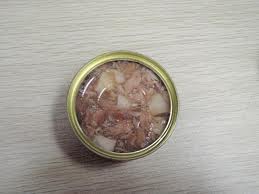

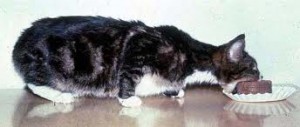
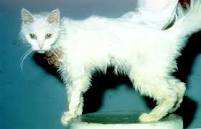
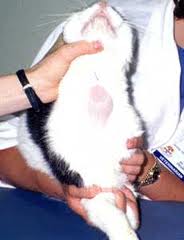
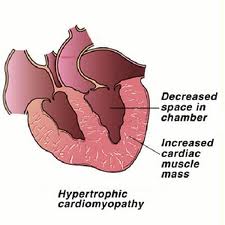
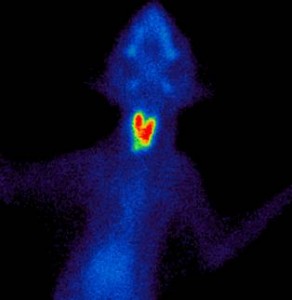
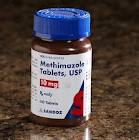
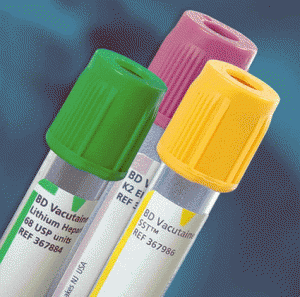
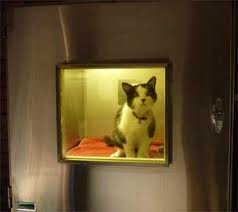
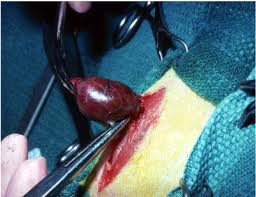
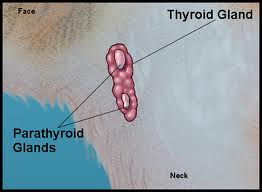
Leave a Reply
You must be logged in to post a comment.